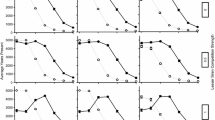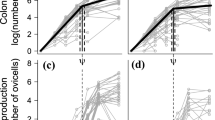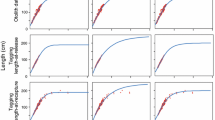Summary
A model predicting optimal timing of growth and reproduction in perennial species with indeterminate growth living in a seasonal environment, is presented. According to the model, the optimal fraction of growing season devoted to growth decreases with increasing individual age and size, which leads to S-shaped growth curves. Winter mortality seems to be a crucial factor affecting the timing of growth and reproduction, under the same function describing the dependence of growth rate and reproductive rate on body size. When winter mortality is heavy, it is often optimal to start reproducing in the first year, and to devote a large proportion of the subsequent years to reproduction, thus leading to small adult body sizes.
The model has been applied to two species of mollusc and one species of fish. The model predictions fit well to the field data for these three species.
Similar content being viewed by others
References
Ballinger, R. E. (1979) Intraspecific variation in demography and life history of the lizard,Sceloporus jarrovi, along an altitudinal gradient in southeastern Arizona.Ecology 60, 901–9.
Ballinger, R. E. and Congdon, J. D. (1981) Population ecology and life history strategy of a Montane lizard (Sceloporus scalaris) in southeastern Arizona.J. Natur. Hist. 15, 213–22.
Bertness, M. D. (1981) Pattern and plasticity in tropical hermit crab growth and reproduction.Amer. Natur. 117, 754–73.
Connell, J. H. and Sousa, W. P. (1983) On the evidence needed to judge ecological stability or persistence.Amer. Natur. 121, 789–824.
Dempson, J. B. and Green, J. M. (1985) Life history of anadromous arctic charr,Salvelinus alpinus, in the Fraser River, northern Labrador.Canad. J. Zool. 63, 315–24.
Intriligator, M. D. (1971)Mathematical Optimization and Economic Theory. Prentice-Hall, Englewood Cliffs, NJ, USA.
Kozlowski, J. and Wiegert, R. G. (1987) Optimal age and size at maturity in annuals and perennials with determinate growth.Evol. Ecol.,1, 231–44.
Law, R. (1979a) Ecological determinants in the evolution of life histories. InPopulation Dynamics (R. M. Anderson, B. D. Turner and L. R. Taylor, eds) pp. 81–103. Blackwell Scientific Publications, Oxford.
Law, R. (1979b) The cost of reproduction in annual meadow grass.Amer. Natur. 113, 3–16.
Law, R., Bradshaw, A. D. and Putwain, P. D. (1977) Life history variation inPoa'annua.Evolution 31, 233–46.
Perron, F. E. (1983) Growth, fecundity, and mortality ofConus pennaceus in Hawaii.Ecology 64, 53–62.
Reznick, D. and Endler, J. H. (1982) The impact of predation on life history evolution in Trinidadian guppies (Poecilia reticulata).Evolution 36, 160–77.
Schoener, T. W. (1985) Are lizard population sizes unusually constant through time?Am. Nat. 126, 633–41.
Sparholt, H. (1985) The population, survival, reproduction and food of arctic charr,Salvelinus alpinus (L.), in four unexploited lakes in Greenland.J. Fish. Biol. 26, 313–30.
Tilley, S. G. (1973) Life histories and natural selection in populations of the salamanderDesmognathus ochropaeus.Ecology 54, 3–17.
Vahl, O. (1981a) Energy transformation by the Iceland scallop,Chlamys islandica (O. F. Muller), from 70°N. I. The age-specific energy budget and net growth efficiency.J. Exp. Marine Biol. Ecol. 53, 281–96.
Vahl, O. (1981b) Energy transformation by the Iceland scallop,Chlamys islandica (O. F. Muller), from 70°N. I. The population energy budget.J. Exp. Marine Biol. Ecol. 53, 297–303.
Author information
Authors and Affiliations
Rights and permissions
About this article
Cite this article
Kozłowski, J., Uchmanski, J. Optimal individual growth and reproduction in perennial species with indeterminate growth. Evol Ecol 1, 214–230 (1987). https://doi.org/10.1007/BF02067552
Issue Date:
DOI: https://doi.org/10.1007/BF02067552




